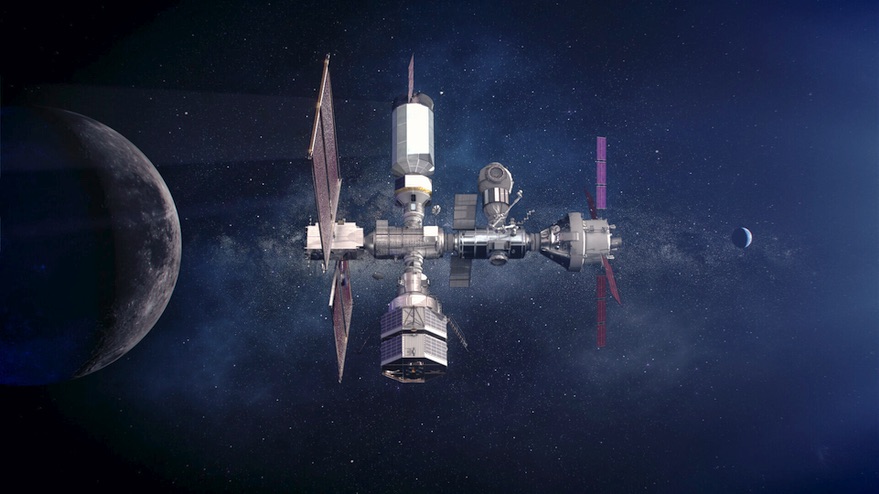WASHINGTON — While NASA and the European Space Agency hailed an agreement this week to work together on the lunar Gateway, both agencies have work ahead to establish international cooperation on the overall Artemis program of human lunar exploration.
NASA and ESA announced Oct. 27 that they had signed a memorandum of understanding (MOU) to cooperate on the lunar Gateway. The MOU extends the existing intergovernmental agreement for the International Space Station to the Gateway, a human-tended outpost in orbit around the moon intended to support crewed missions to the lunar surface.
“This partnership leverages the outstanding cooperation established by the International Space Station as we push forward to the moon,” NASA Administrator Jim Bridenstine said in a statement about the agreement. “Gateway will continue to expand NASA’s cooperation with international partners like ESA, ensuring the Artemis program results in the safe and sustainable exploration of the moon after the initial human lunar landing and beyond.”
Under the agreement, ESA will provide for the Gateway a habitation module called I-Hab and a telecommunications and refueling element called the European System Providing Refueling, Infrastructure and Telecommunications (ESPRIT). ESA will also build two additional service modules for the Orion spacecraft.
Those contributions were long planned. ESA secured initial funding for its Gateway contributions at its Space19+ ministerial meeting in November 2019, and awarded contracts for I-Hab and ESPRIT Oct. 14. ESA highlighted its contributions to lunar exploration, including its Gateway work, at an event at the International Astronautical Congress (IAC) Oct. 14 whose participants included Bridenstine.
In return, NASA will provide opportunities for European astronauts to fly to the Gateway. “This MOU marks a critical point in Europe’s trajectory: it confirms we are going forward to the moon, not just in terms of equipment and technology, but also with our people,” Jan Woerner, ESA director general, said in a statement.
The announcement of the MOU did not mention how many European astronauts would fly to the Gateway. NASA spokesperson Gina Anderson said Oct. 28 that the agreement includes three “crew opportunities” to the Gateway, although specific missions and dates for them have not yet been determined. The agreement only addresses flights to the Gateway, she added, and not missions to the lunar surface.
Neither NASA nor ESA have released the text of the MOU. Anderson said the MOU “is an important and unique agreement that is part of a package of agreements with our other intended Gateway partners,” notably Canada and Japan, which are still being negotiated. “Upon completion of the agreements with Canada and Japan, NASA plans to release the three MOUs as a package,” she said.
Both Canada and Japan have stated their intent to participate in the Gateway. The Canadian government announced in February 2019 it would build a robotic arm system, called Canadarm3, for the Gateway. The Japanese government signed a cooperative agreement with NASA in July that outlined Japan’s roles in human exploration, including potential contributions to the Gateway.
NASA has not yet finalized the agreements with Canada and Japan, Bridenstine confirmed when asked about it during an Oct. 28 speech at the American Astronautical Society’s Wernher von Braun Memorial Symposium. “I don’t have anything to announce as far as those negotiations,” he said. “Stay tuned, because we’re getting close.”
Bridenstine said that NASA has been in discussions with “every entity that is part of the International Space Station,” which would also include Russia. However, at the IAC Oct. 12, Dmitry Rogozin, director general of the Russian space agency Roscosmos, criticized the Gateway as being “too U.S.-centric” and said that “Russia is likely to refrain from participating in it on a large scale.”
While ESA has signed the MOU with NASA for cooperation on the lunar Gateway, most of its member states have yet to sign on to the Artemis Accords, the principles established by NASA governing participation in the overall program. Three of ESA’s 22 member states — Italy, Luxembourg and the United Kingdom — signed the document at an Oct. 13 ceremony, along with Canada, Japan, Australia and the United Arab Emirates.
The provisions in the Accords about the right to extract and use space resources could be a stumbling block for other ESA members, though. “Those 22 member states have quite different positions on how this should be addressed,” said Sylvie Espinasse, head of ESA’s Washington, DC, office, during an Oct. 27 panel discussion at the von Braun Symposium.
There’s agreement among ESA members on the importance of using lunar resources to support sustainable lunar exploration, but differing view on how resource utilization should be managed. “We cannot ignore the elephant in the room on the challenge of regulation, how we will utilize those resources,” she said.
“ESA will listen carefully” to all its member states, she said, as well as future discussions on space resources at the United Nations’ Committee on the Peaceful Uses of Outer Space. “And then, as how ESA has always managed at the end, we will find a way to propose to them an exciting package of lunar surface activities and how to contribute to Artemis, and we will find a way to get a legal framework that is satisfactory to all of them.”
